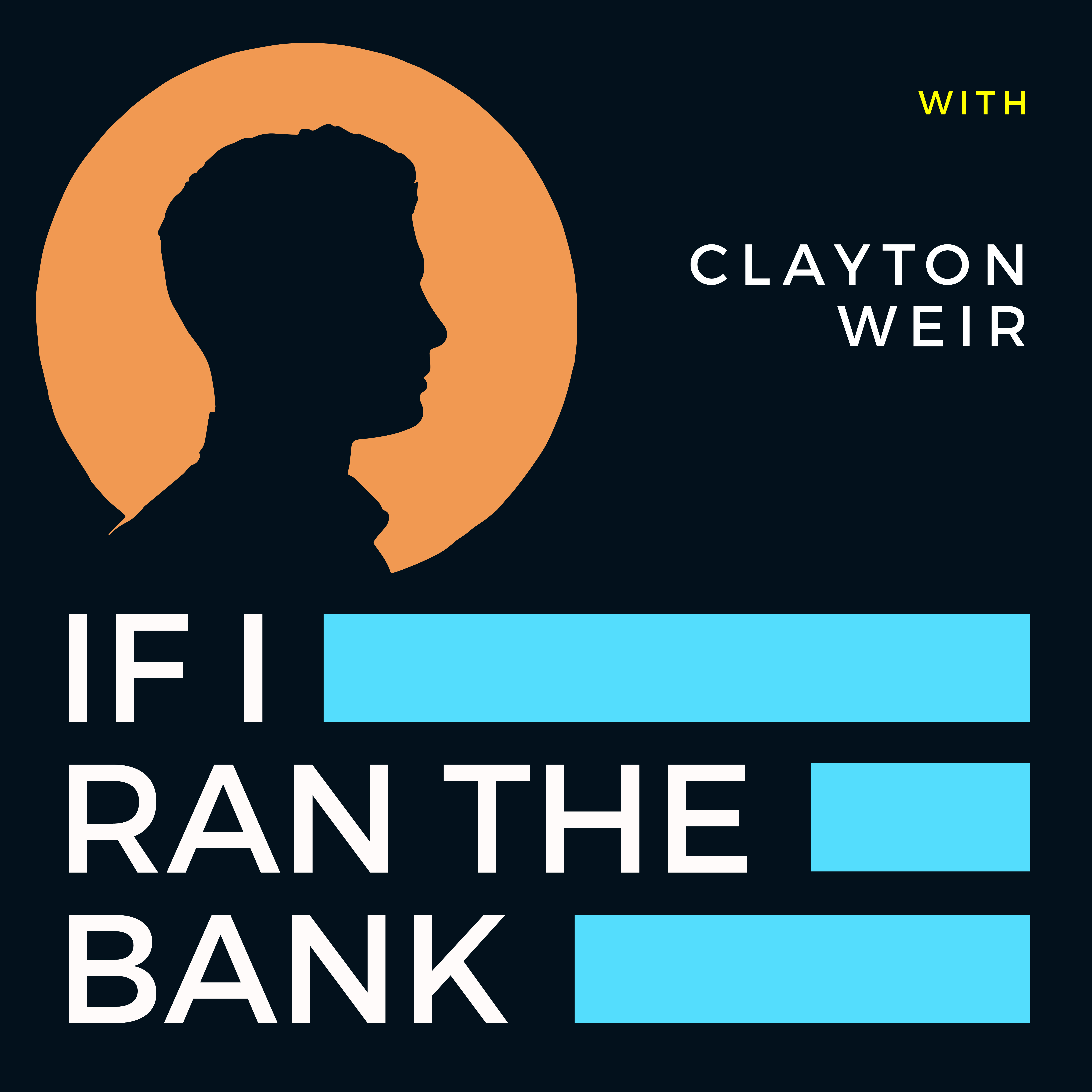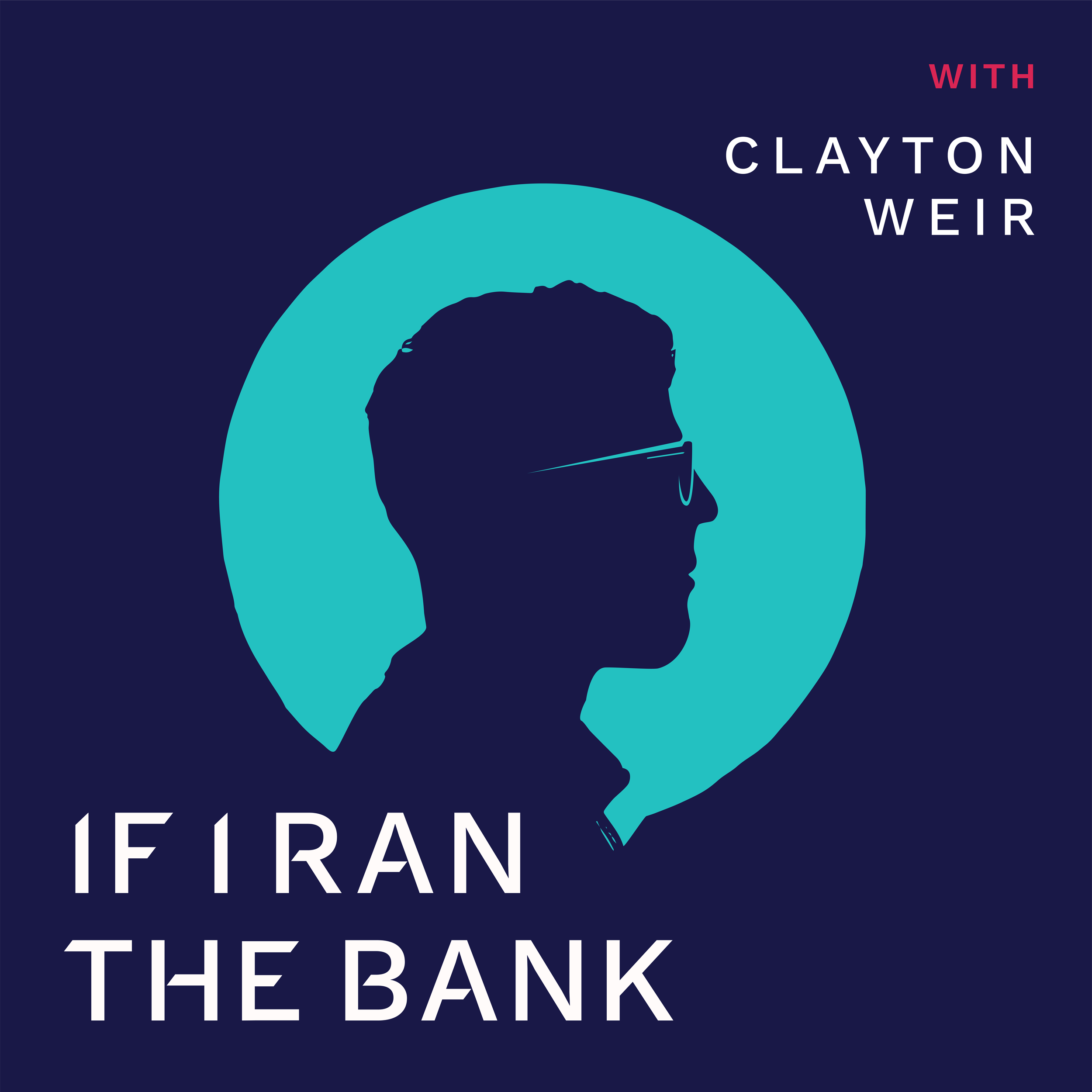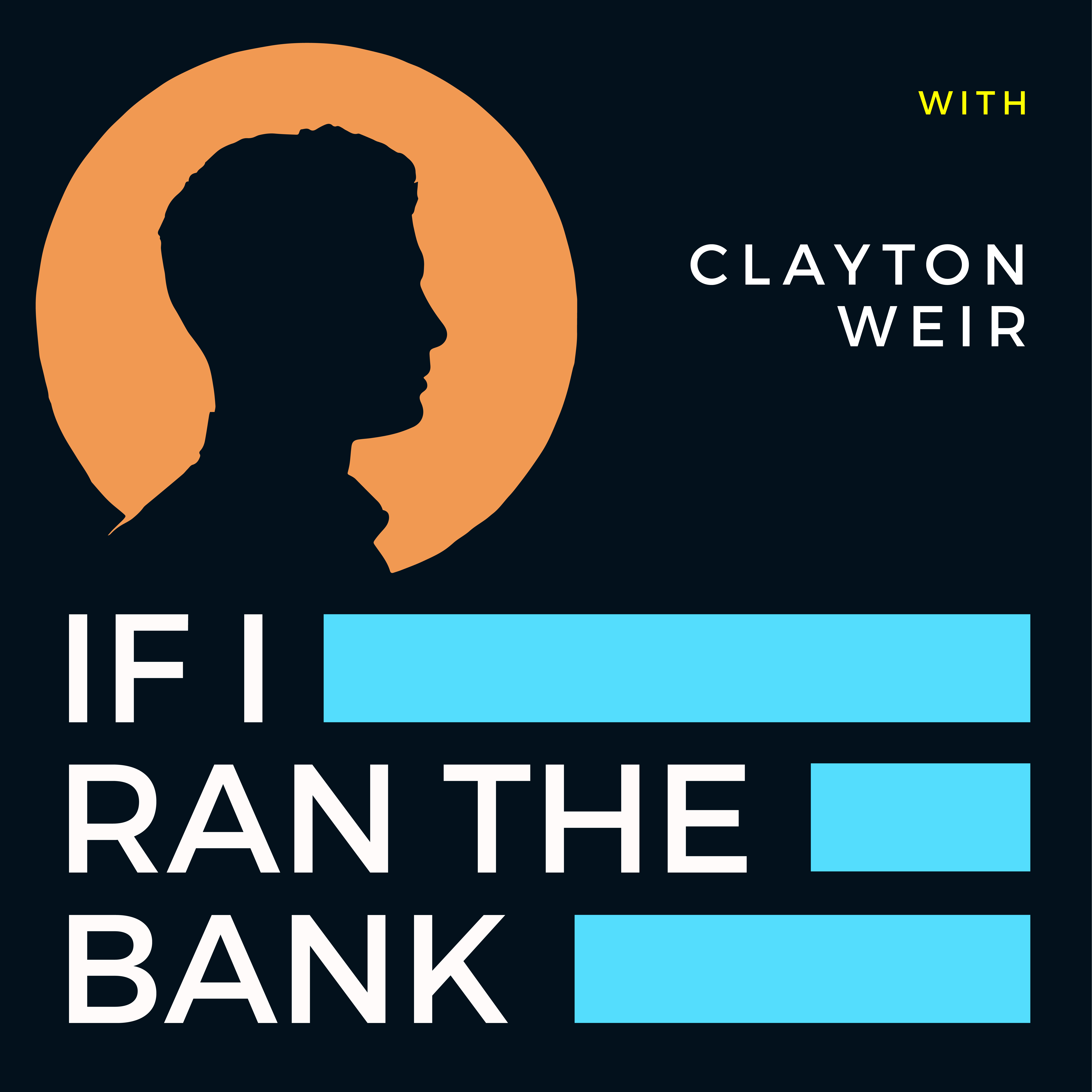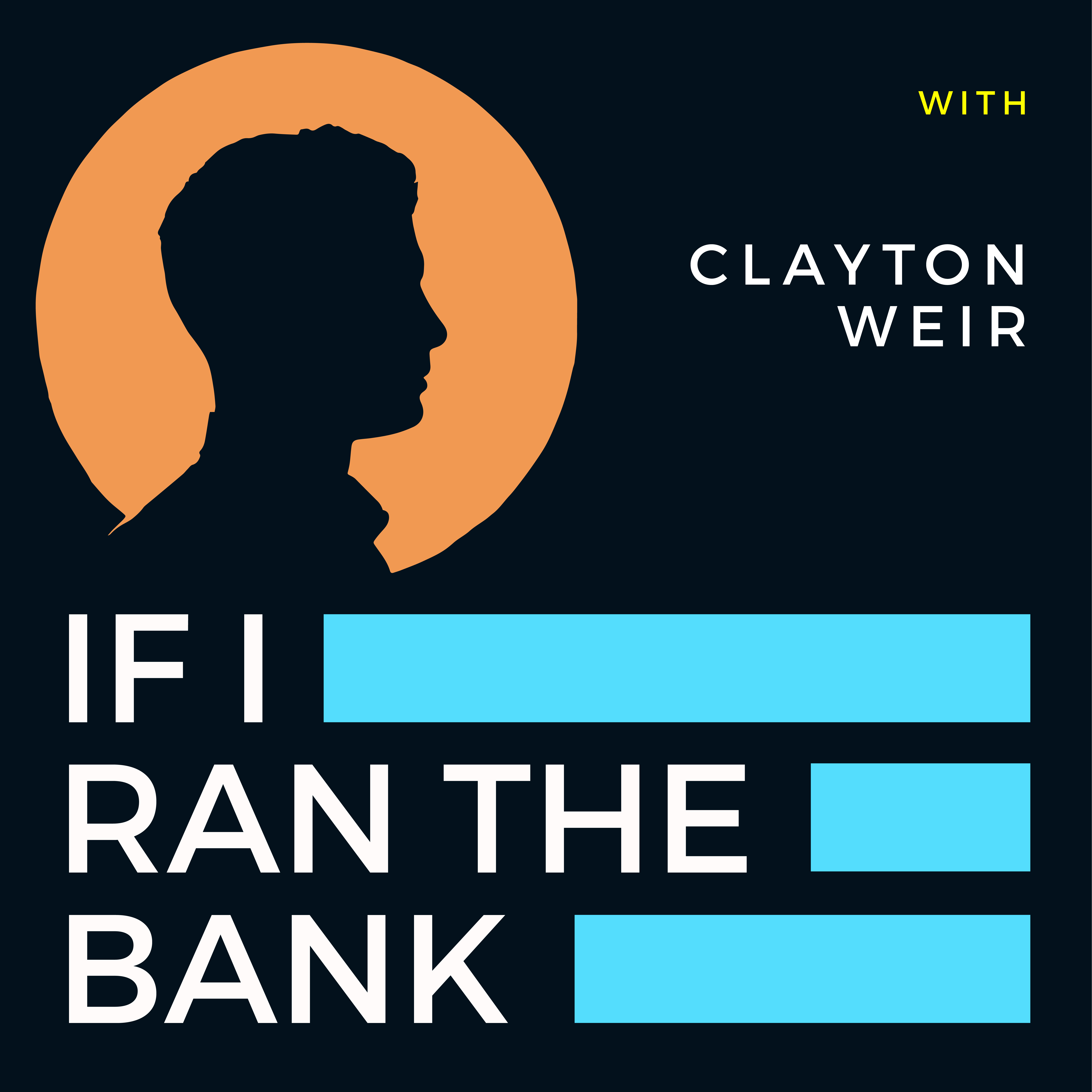Reed Luhtanen Would Push for Ubiquitous Instant Payments
- 0.5
- 1
- 1.25
- 1.5
- 1.75
- 2
Speaker 4: If I Ran The Bank.
Speaker 1: If I Ran The Bank is a podcast hosted by Clayton Weir, co- founder and head of product and strategy at FISPAN, a FinTech that is enabling banks to provide contextualized consumer life experiences to their business clients. Clayton's a thought leader in financial innovation and hits on the hottest topics in banking, finance, and the future of payments. And he wants to know if he ran the bank, what's the one thing you'd go all in on? Please tune into Spotify, Apple Podcast, Google Play, or wherever you get your podcasts. And now, here's your host, Clayton Weir.
Clayton Weir: Hey everyone. Welcome to another episode of If I Ran The Bank. I'm your host as always, Clayton Weir, and today's guest is Reed Luhtanen, who's executive director of Faster Payments Council. I came to know Reed as a very opinionated, smart person with also the glorious beard, I should say, on a random industry Webex last year. And when I started the podcast, I knew this was a voice that I'd want to share with you all. Trained as a lawyer originally, which we're not going to hold against him. He's had a very interesting career with a number, I think, of different missions within the treasury payments and broader business operations functions at Walmart. Most of you know it's the world's largest retailer and probably business in general by most measures and I think a company that actually sits at a very interesting part of the financial services industry due to the nature of some of the communities that they serve. Reed's now the executive director of the Faster Payments Coalition, as I said, which is a trade association that I would describe as trying to accelerate the ubiquity of faster payments in the US. Reed, thank you so much for coming on the show.
Reed Luhtanen: Absolutely. Really excited to be here. Thanks Clayton.
Clayton Weir: Is there anything in your background that you want to kind of clean up or clarify there?
Reed Luhtanen: No, I think you hit it all well. I'm just excited to be here to talk about faster payments as always. You mentioned I'm running the FPC now. If you'd like, I can go into some depth on what the FPC is and what we're focused on and how we're constructed.
Clayton Weir: That would be awesome.
Reed Luhtanen: Great. Great. So as Clayton mentioned, I'm the executive director at the US Faster Payments Council. The FPC is an industry- led member organization, whose mission is to facilitate a world- class payment system where Americans can safely and securely pay anyone anytime, anywhere, with near immediate funds availability. So I'm responsible for managing the daily operations of the organization, creating and executing on that strategy around what I just mentioned, and also while includes ensuring an inclusive and transparent dialogue with all of our stakeholders. So the FPC is a little bit unique in that unlike other trade associations or industry organizations, which are generally assembled around a particular industry vertical, the FPC is really assembled around a concept or idea. That idea is ubiquitous, safe, easy to use, faster payments are going benefit all of us. So we bring together all the different facets of the payments ecosystem, which includes business end users, such as Walmart, who you just mentioned, my former employer, but also Microsoft and Netflix and Airbnb, so a host of variety there, consumer organizations like the National Consumer Law Center and Citizens For Responsible Lending, financial institutions that run the gamut from the very, very largest, so Chase and Citi, mid- tier banks, and credit unions and then small community credit unions and financial institutions and banks. So the whole 50 or 60 financial institutions that are membership. Payment network operators, including all of the folks that you might think about, Visa and MasterCard. The clearing house is a member actually and also the Federal Reserve is a member of ours, which is a bit unusual and unique for us. Technology providers, so very large ones again like FIS and Fiserv and Jack Henry and ACI Worldwide, but also a host of really startup type, innovative folks, a lot of folks focused on crypto and Blockchain. So tremendous variety there as well. And then a catch all for ones that we lovingly call others, so mostly trade associations, consultancies, et cetera, and actually a few law firms, that of course I'm biased towards myself.
Clayton Weir: We would've hated for others to go underrecognized that the coalition's crosstalk
Reed Luhtanen: Got to love... Got to...
Clayton Weir: Could you made a bucket?
Reed Luhtanen: Got to give the others their love.
Clayton Weir: Very good. So on that note, I think you raised an interesting point, right? It's legitimately a coalition and in some ways, those are... is an assembly of audiences that wouldn't always be in the same room talking to each other at the same time about these issues. And I guess that just goes to... Maybe how I'm just putting random words on kind of in your mouth, but I guess it's the magnitude and the importance, and just kind of the point in history are in terms of now building... Purpose building, I guess, a financial system that is appropriate for the nature of commerce in life in 2021. Right? And going forward, it's a very different worldview look.
Reed Luhtanen: Yeah, absolutely. I think you hit the nail on the head there, that what we're talking about is very intentionally and very, to a certain extent, methodically, and maybe even more methodically than some would have preferred. We're doing something for the first time in what, 50 or 60 years, in that we're rebuilding the payments infrastructure of the world's most complicated and complex economy while we're obviously still engaged in tremendous levels of digital and remote commerce that necessitate the types of payments that we're trying to improve upon through what we're doing here at the FPC. So you've got simultaneously, obviously huge scale for the clearing house and the Fed on ACH, obviously huge scale for the likes of Visa and MasterCard, et cetera, through card- based payments. And all of those are sort of here, involved in this effort to advance the US towards these faster, whether that be instant or immediate payments.
Clayton Weir: With the different audiences you laid out, and I don't want to put you in the corner to put words in their mouths, but can you maybe give us kind of a single sentence, especially for the four kind of core audiences, like what their interest is in sitting at the table on something like this or what you think their kind of core concern or objective is, however you want to characterize it?
Reed Luhtanen: Yeah. Yeah, absolutely. I think the primary reason why folks want to be engaged with the FPC, it can vary quite a bit depending on the constituency, as you might imagine. I think there's a lot of desire among various, especially the large scale players, to be there to influence these outcomes and to ensure that the interests of say business end users and financial institutions and technology companies and networks are harmonized in a way that allows for ultimate result that is palatable and hopefully, even better than palatable for all those different constituencies. At the same time, I think there are a lot of folks who are here because they want to be part of the conversation. They want to get information. They want to get educated and be part of that dialogue. And so I think to a certain extent, the narrow focus of the FPC allows that to happen and allows for really rich, in- depth dialogue on a pretty specific topic, but one that is on the precipice of becoming the mainstream focus of the payments ecosystem in the United States. So I think there's a lot of interest there and just being here for that dialogue and learning from the others who have sort of broken the ice ahead of you and also ensuring that the different perspectives are heard. So I think there are people who are here out of a sense of obligation almost, or a sense of wanting to make sure that what we end up with in terms of core settling in settlement infrastructure for the United States can really serve all the needs that it needs to going forward. So there are folks here who say," What if other, say insurance companies, aren't going to have the bandwidth to step up? We want to make sure that that constituency is heard and understood." And the same thing goes for financial institutions, right? So their FIs who say,"You know what? I got to make sure that the community financial institution voice is heard in these conversations and voiced in a way that makes sure that everybody's perspective is understood so we can move forward with solutions that truly do work for everybody."
Clayton Weir: Totally makes sense to me. And just when you talked about that, about specificity, I think applying clarification, I'm just going to make an assumption. I know sometimes because we use the word real- time payments, I have specifically used the word faster payments on purpose, but sometimes just these terms get mixed up with the brand name, for example, real- time payment rail, right? That has been instructed by it. I'm assuming your work and concept is broader than any one clearing system or any one tool. It's the ubiquitous idea of these mesh up, probably multiple clearing schemes and tools that we're going to need to solve all these problems. Is that a fair assumption as well or...
Reed Luhtanen: Absolutely. Yes. So we have a pretty broad view of what a faster payment is, and it includes what you would think of as real- time payments or what the International Bank of Settlement has defined as fast payments, so true RTGS, clearing house RTP style payments. So the RTP being one of those and Fed now being the other one on the... It's coming on the horizon, but then also sort of zooming out and saying," Well, really, there's this other category called immediate payments." And so that involves real- time messaging that allows the sender and receiver to know that," Hey, this has happened. It's a done deal. The funds have moved from one account to the other." At least in the messaging layer, and now settlement might be later that day or the next day even, but... And then, honestly we actually even include same day ACH in a lot of what we talk about because there's a lot of value and even speeding up ACH to be same day. So they're big umbrella approach for sure.
Clayton Weir: Yeah. I thought that wording, I thought I saw some on your website in the mission and even references, just talk about that, about things just settling fast or funds becoming good fast. Some of that is entirely more about business process and informational interaction probably than it is than the laws of physics on the actual payment clearing system itself necessarily. Right?
Reed Luhtanen: Yeah. For sure. And a lot of what we're looking at and what we're hearing about has to do with how is that information exchanged between the sender and the receiver to ensure that both parties have the transparency, which can often be lacking in various transaction flows. How do we speed up to allow for, even for example, cross border transactions, which can be a really, very difficult thing to solve for in terms of transparency to the users of the system. So yeah, there's lots of information gaps there. I think one of the things that we talk a lot about is how does it not only about the speed, but also that data layer that can be associated and included with the ISO 20022 messaging that can really add value for end users.
Clayton Weir: I think, as any good sort of advocacy type professional, you gave me your boiler plate on the mission of FPC, but could you maybe expouse on that, maybe in more human terms or kind of more real world scenarios, like what does success look like for you guys? Right? If we start to play this forward five and 10 years, and it's now time disband the faster payments scouts. All right. The world is sufficiently... What would that look like? What would that mean for people and businesses and banks? Can you maybe walk us through that?
Reed Luhtanen: Yeah. Sure. Why, I don't foresee a time when we won't need FPC. Hopefully, I've got enough foresight to evolve our mission to avoid running myself out of a job, but you know what? If that happens, so be it. So absolutely. So I think first off, we talk about ubiquity a lot and that's maybe not a word that everybody uses every day, but what we're thinking about is how can we make it so that it's possible for every demand deposit account in the United States to reach every other DDA in a way that allows for immediate or instant transacting? And in doing so, that's sort of like the foundational layer, but then how do we also, I talked about safety, so doing that in a way that ensures that you're not compromising the structural integrity of the payment system, that you're not creating risks that are unnecessary or unwarranted, that you're not opening people up to loss and that you're educating people and ensuring that people understand to the extent these payments are different than maybe other electronic payments that they've done in the past, how are they different? Why are they different? And what are the implications of those differences for them in terms of liabilities? And then also, like I mentioned, ease of use, right? So I think to a large extent, the first thing ubiquity is... I sort of flip it to say it's easy, but compared to ease of use, I think the major networks would tell you that the more difficult thing about building a network and scaling it and getting it to be used by millions and millions of people is figuring out what are those experiential layers like? How do you make it easy for a business to pay another business? How do you make it easy for a consumer to pay another consumer to pay a business? How do you make those transaction flows simple and quick and easy and frankly, make the experience for the customer as quick and easy as the payment underlying payment really ends up being with these systems?
Clayton Weir: No. I think that makes sense on both of those. And I think they ask, they kind of baked a million other questions, but on the sort of... Also, I find it hilarious that you effectively defined ubiquity as a word that itself was non- ubiquitous, which was a point of punditry that we've now entered into the record, but in terms of DDA coverage, right? Or the number of bank accounts in the United States that have access to this, the last time I heard, and this may fit over a year ago, was it was somewhere around, I thought half that could maybe receive a payment, is that sort of changed or what's the state of that? And maybe if you have the kind of send number, it'd be great just to context that for people.
Reed Luhtanen: Yeah, it has changed considerably. So the percentage of DDAs that are connected to RTP, the clearing house's real- time payments network is now over 70%. So they've grown quite a bit in the last six to eight months in terms of their connection for receive. I mentioned Visa and MasterCard before, they're of course connected to virtually a hundred percent of the DDA. So you think about a service like say Zelle, which is more of a messaging service that leverages multiple different networks for payment and settlement, including the ones I just mentioned. They're able to reach essentially a hundred percent of accounts as well through the various relationships they have. So there's a lot of activity happening in this space for sure and a lot of growth. The clearing house tells us that each month, they're seeing millions of transactions for billions of dollars through the RTP network, for example.
Clayton Weir: Wow. Which is really interesting. It just seems to be... It's one of these things where it's kind of a slow compounding on some interesting announcements around the transaction limits on same day ACH recently, which fundamentally change its usability in a lot of B2B contexts and things like that. I assume probably that'll trickle down to RTP limit size eventually as it kind of has historically. So now those are kind of interesting data points. And in terms of that, like in terms of where we are in that overall journey between now and the world you want to live in, are you kind of happy with the state of progress? Do you think it's fast enough? Can you maybe just add some color to that?
Reed Luhtanen: Yeah. Yeah. I think it's easy to say that we're not happy with the progress we've made, right? The group of industry colleagues that I worked with through the Fed's Governance Formation Team set the date as 2020 that we were going to reach ubiquitous instant payments. And obviously, we didn't make that goal, right? So it's already 2021 and we're where I just say 70% for receive. So we're behind what we thought where we thought we would be three or four years ago. That being said, I don't think anybody could have known how hard and how complex and how complicated which this was going to be. There's a lot to this. I think we all understood some of the ramifications about the speed and how that can be more complicated for financial institutions. But I think some of the other things that we didn't really realize, or maybe take into account were the complexity associated with going from banking hours for transaction processing, eight hours, nine hours a day for five days a week to 24/7/365 transaction processing, and the implications of that throughout the payments ecosystem. That's a difficult endeavor to say the least. So I think there's complications there. And obviously, not that we were going to make it in 2020, but for the COVID- 19 pandemic. But I think that that is the case in point of there are just lots of competing interests and a lot of different things that financial institutions and corporates and technology companies can be focused on. And that has to be that there's a reason for them to focus on this. And I think we're starting to get there now, but that's got to be in light of lots of different other things that are hitting the CEO's inbox at a bank. So there's a lot of work still to do.
Clayton Weir: On that note, and I totally agree. Right? There's tons of distractions and it strikes me as no matter how philosophically aligned you are to this and how much I believe that I want to come back to this kind of the ease of use or the experiential layers that are going to build around this thing, that's fascinating. But you can believe in all that and it can still be very hard to get, I think, the right investments and projects and funding on this stuff authorized if you're sitting in a financial institution or wherever it might be. Right? And so what's your kind of Coles Notes there in terms of how do you build a case? How do you get more bodies, more dollars into this, if you are an FI? I don't think that probably applies to the top four or five or 10, a stitch to the US, but I think as you go down into the kind of messy middle, it gets harder and harder and harder up to the point where you're eventually just kind of waiting for FIS and Fiserv and Jack Henry to solve this for you. But curious if you have any thoughts.
Reed Luhtanen: Yeah. I think primarily, there's a couple things to talk about there. One is a good friend of mine who is clearly biased, he works for the clearing house, told me that there are no fast followers here. So I think talking about how you're either a follower or you're a leader. And there's a lot to be said for being a leader in this space and being out in front of this and having all the learnings that comes with implementing early and investing in this space early, when you know that at the end of the day, this is going to be the way that people transact in the future. The other thing that we talk a fair amount about is there are some very real threats to financial institutions that continue to emerge in the FinTech space. Pretty much every day or every week you read about somebody else who is entering this space and trying to serve the very same customers that are served today by financial institutions. And a lot of what they're talking about is how they make payments easier, and more intuitive, and simpler for customers. You think about all the different apps we have on our phones to solve something that I think banks are very well- situated to solve for their customers in a way that keeps that bank brand front and center, as opposed to the brand of another, of a FinTech that doesn't create a deeper relationship between the bank and the customer. So I think there's lots of reasons to be engaged and involved here that go to kind of the core of what it means to be a bank, which is ensuring that people want to engage with you for their financial operations and their financial lives.
Clayton Weir: And so it sounds like on that note to now kind of maybe put that in context back with your point about kind of ease of use and the ubiquity of really nice experiences around this. And for sure, I think the most obvious one is in sort of peer- to- peer, and we've seen a preview into it with Zelle and with, I can't think of what the payphone real- time peer- to- peer product is right now, but if we don't have it in Canada. But those were that. But I think there's going to be just an absolute explosion of all kinds of use cases. I think lots of very vertical, specific and niche things, whether it's in payroll, whether it's in the way businesses transact with each others. Certainly, you see it in the way insurance company use, or high frequency kind of small volume payment to consumer type entities like that are going to... Do you think that the banks are going to create the majority of those experiences? Or do you think it's going to be non- bank entities? Or do you think it's just going to be a mix? And curious, your thoughts on that.
Reed Luhtanen: Yeah. I'm going to take the punt answer here that it's going to be a mix. So I think... Yeah, I think there will be a lot of this can and my opinion should be built into the bank app. Now a lot of banks obviously are outsourcing the creation and development of their apps to third parties anyway. So even a bank experience might not be created by the bank, even if it's ultimately in a bank branded app. But you think about things like Zelle, right? So many times Zelle is embedded within the banks app. Do you think about even broader than that though? We have a work group at the FPC that's working on QR codes as an example of one of those experiential ways to conduct a faster payments transaction, which has been very successful in other markets around the world, if you look at India and China, even some in Europe. And thinking about if you're a financial institution and your customer is interested in using that sort of interface to conduct a payment, it might make sense for you to embed that within the bank app so the customer becomes even more reliant on your app to transact, right? So instead of opening up X or Y payment app, you open up your bank or credit union application to scan that QR code to push that payment. We've got a work group also looking at recurring payments. So you mentioned bill pay earlier and payroll. What are some of those repeated payments that people are making that could stand to make sure that you have the same type of experience that doesn't require them to engage every single time? You've got$ 15 that you owe Netflix every month. You shouldn't necessarily have to go in and authorize that$ 15 every single time. So how can we figure that piece out and how can we make that easy for the customer? And then, thinking about even deeper, what are some ways that we could leverage APIs to connect together different applications on a phone to allow for a seamless experience that keeps the brands that are involved in the transaction front and center to the customers that they're both trying to serve?
Clayton Weir: No, it makes a lot of sense. I obviously dumped a laundry list of probably the most obvious or at least all ones that I read about the most and didn't think of myself. Are there less obvious sort of use cases or things that you think are going to happen that you might want to highlight?
Reed Luhtanen: Yeah. I can't remember all the ones you mentioned, but the ones that have been sort of interesting to me as I've been talking to folks have been gig economy specifically. So you mentioned payroll, but specifically, pushing funds quickly to gig economy workers. So especially if you have been living through this pandemic, which we all have been, I would guess that many of our listeners have been ordering from restaurants and having it delivered more often the past year than maybe they did before. And whether it's Bite Squad or DoorDash or whatever, whichever app you use, some of us use more than one, those drivers are incentivized by speed of pay in a way that you might not think about. And so there's competition for drivers even for that, so that they can pay instantly. Another interesting one is merchant settlement. So think about a merchant who's even accepting traditional credit, debit cards today, but in this, particularly again in the last year, there's been a big cash crunch, cash flow issues for lots of merchants out there. So being able to speed up settlement to where you're getting paid even multiple times per day for your day's credit card and debit card receipts has been something that has driven some volume through those networks as well, which I thought was kind of interesting.
Clayton Weir: No. I think both of those are fascinating. And I think to some extent, those two things, what's interesting about them is in a way I've viewed them as linked a little bit, right? So the innovation, the gig economy folks were trying to do around push to real- time. If you're going to pay per ride, you kind of need to get paid per ride, right? Not three days after they slide Reid's credit card for the food order. And so it kind of put pressure kind of up through the value chain that... I don't know and I don't know if anybody knows, but it strikes me as the settlement time on retail merchant processing accounts must have lost days of kind of over the past couple of years. Right? This has been pressure on kind of there was... Some of those situations were like a week later, right? You've got your cash- in bank from your merchant processor, this now kind of... It's kind of on a journey to real- time, it feels.
Reed Luhtanen: Yeah. As somebody you mentioned, I was at Walmart for 15 years. I can tell you that the speed of settlement is very important, especially for a very large scale retail, right? So being able to get those funds at least the next day, if not the same day, is a big deal. Even for large scale merchants like that, you're not worried about being able to pay the bills, but you still have reasons why you want those funds to be available to you. And it's interesting because, and not to go too deep into my past, but when I was at Walmart, when we were meeting with the Fed and this was years ago when they were launching the whole strategies to improve the payment system project, and I told them exactly what you just said, which is you can't only speed up one flow of payments, right? You can't say," Merchants, now you can pay faster to your suppliers," without saying that you're also going to speed up the inflow of funds because for most businesses, I think this is sort of B- School 101, like your P& L is great and if you're showing you got a bunch of receivables, that's great, but really, you need cashflow, otherwise you run out of cash, you can't pay your bills and you're out of business, whether you have receivables or not.
Clayton Weir: Totally makes sense. While we're on it... I could probably spend all day on it. It's obviously such an interesting organization, right? But one thing that strikes me is a neat parallel between Walmart and what we're talking about is the B2B aspects of faster payments are really about the integration of context, right? So the exchange of things like POs and invoices and rich structured data, so I can match cash and authorize payments more quickly and reduce admin cost. And in some ways, we have a predecessor to that in EDI or electronic data exchange, and for most organizations, that didn't really ever work because some things you need, right? And the 1980s technology and the state of techno didn't work. But I always understood Walmart to be somebody that did live in a world where that worked. Right? And I think just because they're such a big center of gravity, got a lot of their vendor relationships kind of automated on EDI and that kind of thing. Is that true? That's just my outside, kind of you hear these stories about it and do you want to expouse on that in any way?
Reed Luhtanen: What I would say is kind of steering away from the inner workings of Walmart and talking more about it is absolutely a critical value of these new payment systems that you're able to have almost conversational payments where the context is right there with the payment in a way that I don't believe has been the case in the past. So having the ability to automate even further your reconciliation processes, having the ability... Say you're an insurance company, having the ability to tie together the claim with the payment, with the account, with the customer in a way that ties that all together and makes it all very transparent to everybody involved what's going on and why the payment has arrived. It's sort of funny to say, and I think anybody who's been in any sort of business knows that receiving a payment and not knowing what it's for is almost as bad as not receiving it at all. In some cases worse, right? Because now you're having to spend a bunch of effort to track down why did this money arrive in my account? Who did it come from? And what is it sort of offsetting in terms of my receivables? That being automated in a way that is sort of inherent to a payment system can really revolutionize a lot and create a lot of efficiency in the back office.
Clayton Weir: I was at an AFP conference once and it was some treasure product. I swore that... I can't remember the company. They had, I would say it was in the billions of dollars of unallocated cash on their balance sheet, just money that somebody had set up that they could never quite figure out why or where it was supposed to go. So it was almost certainly owed to them. They just didn't know exactly where it was, how to account for it. That's there forever, I guess, and they must kind of write that off eventually and cleaned it up, but the net against receivables, but it was profound to me the scale that it could be at.
Reed Luhtanen: Yeah. That's a very large number.
Clayton Weir: It's a large inaudible
Reed Luhtanen: For sure.
Clayton Weir: It just...
Reed Luhtanen: Yeah. I don't want to pretend like," Well, we'll just turn on RTP and the Fed now, and that will solve all of this." That's obviously not going to be the case, but I think having it in a way that allows for a level of clarity and transparency that hasn't been available in the past is really going to help a lot of businesses once they adopt it.
Clayton Weir: No, I totally agree in it. It is highly speculative, but going back to your idea about there being there's no fast followers. It's just going to be a big chasm. I think the room to be innovative for the front- running banks on this stuff is immense. Right? I largely think B2B, but I think there's probably ways that a bank start to talk about some of these requests for payment type messages that are very business context being shipped to the network. I think there's ways to put products to your customers where you invite your business partners to bank at bank X with you, because it has this closed loop and automated reconciliation and things like that. I think the future is completely unwritten in terms of the kinds of businesses that banks might find themselves in.
Reed Luhtanen: Yeah. I agree. I think there's going to be a competitive advantage that banks can create for themselves in that for sure. You've already started to see that a bit with... I'm going to forget which one, but one of the delivery services has been actively encouraging their drivers to change financial institutions, to go on to a bank that is connected to the RTP network.
Clayton Weir: Yeah. Make you a massive center of gravity. Right? If you start to have more scenarios like that. We could get into the weeds on this stuff all day, but I think we've gotten to the meat of it. Is there anything, as you kind of sit back on this conversation, that you think is missing or that we didn't touch on in terms of this?
Reed Luhtanen: Yeah. I just think as we're going forward and I think we're all wondering are we in the new normal now or when are we going to be back to normal coming out of this pandemic and what are the implications of some of that stuff for payments? I think it's, again, I guess this is maybe a punt answer, but I think it's a mistake to think that we're already back to where we're going to be. But I think it's also a mistake to think that things are going to go back to the way they were. So I think if you're thinking about payments in terms of which changes happened over the last year that arguably made things better and easier for people in which changes made things not as good, you can probably think through it that way and identify where are some spaces that I should be thinking about investing and getting engaged on the payments space. Right? So groceries as an example. I think prior to the pandemic, I was the type of person, every week I would drive to the store and I would pick out a cart and I would walk up and down the aisles for 45 minutes picking stuff out and then I would go to the front of the store. I'd put all that stuff out of the cart onto the belt. Somebody would scan it, then I would pay for it. And then they would put it back in the cart and I put it in my truck and I drive back to my house and I put it in my house. Now, I can buy groceries faster than I just described the old process for buying groceries. And the implications of that are, I'm not paying for that in the store anymore. I'm paying for that remotely from an app. And I think there's going to be lots of use cases like that that are not going to go back.
Clayton Weir: No, I think that's a great way to probably sum the whole conversation up right there. So why don't we do that? Thanks everyone for listening to these things and you, Reed, for being on the episode today. I think that was really helpful to just kind of walk us through with state of sort of this migration to real- time from your perspective and some of the value of when we get there. So I really appreciate that. Thanks everybody again for listening. If this is your first time listening, feel free to subscribe on Spotify, Apple, wherever you get your podcasts, and send me up to a friend, we always appreciate that. And any questions, comments, or concerns, never hesitate to email info @ fispan. com. F- I- S- P- A- N. com. Have a nice day, everybody.
DESCRIPTION
Reed Luhtanen is Executive Director of the U.S. Faster Payments Council (FPC). Reed joined FISPAN’s Clayton Weir on this episode to discuss the US Faster Payments Council and how they are working towards a future of ubiquitous instant payments.
Today's Host

Clayton Weir
Today's Guests






